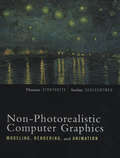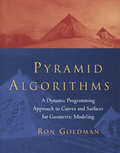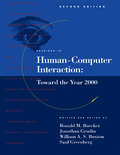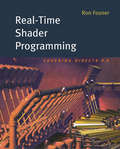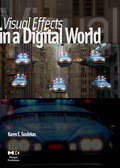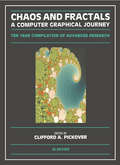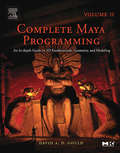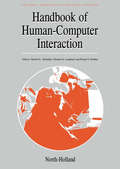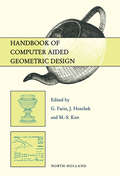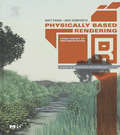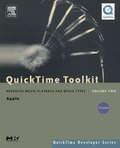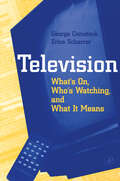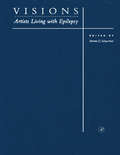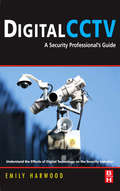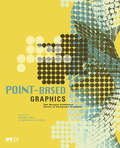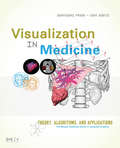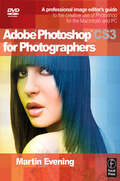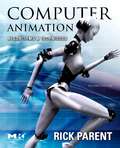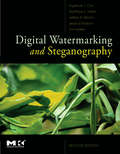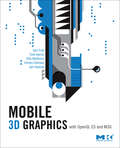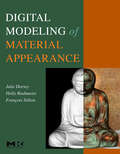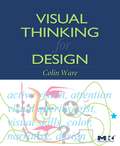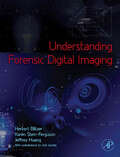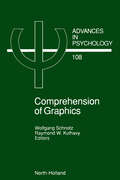- Table View
- List View
Non-Photorealistic Computer Graphics: Modeling, Rendering, and Animation (The Morgan Kaufmann Series in Computer Graphics)
by Thomas Strothotte Stefan SchlechtwegEven as developments in photorealistic computer graphics continue to affect our work and leisure activities, practitioners and researchers are devoting more and more attention to non-photorealistic (NPR) techniques for generating images that appear to have been created by hand. These efforts benefit every field in which illustrations—thanks to their ability to clarify, emphasize, and convey very precise meanings—offer advantages over photographs. These fields include medicine, architecture, entertainment, education, geography, publishing, and visualization.Non-Photorealistic Computer Graphics is the first and only resource to examine non-photorealistic efforts in depth, providing detailed accounts of the major algorithms, as well as the background information and implementation advice readers need to make headway with these increasingly important techniques.Already, an estimated 10% of computer graphics users require some form of non-photorealism. Strothotte and Schlechtweg's important new book is designed and destined to be the standard NPR reference for this large, diverse, and growing group of professionals.Hard-to-find information needed by a wide range and growing number of computer graphics programmers and applications users.Traces NPR principles and techniques back to their origins in human vision and perception.Focuses on areas that stand to benefit most from advances in NPR, including medical and architectural illustration, cartography, and data visualization.Presents algorithms for two and three-dimensional effects, using pseudo-code where needed to clarify complex steps.Helps readers attain pen-and-ink, pencil-sketch, and painterly effects, in addition to other styles.Explores specific challenges for NPR—including "wrong" marks, deformation, natural media, artistic technique, lighting, and dimensionality.Includes a series of programming projects in which readers can apply the book's concepts and algorithms.
Pyramid Algorithms: A Dynamic Programming Approach to Curves and Surfaces for Geometric Modeling (The Morgan Kaufmann Series in Computer Graphics)
by Ron GoldmanPyramid Algorithms presents a unique approach to understanding, analyzing, and computing the most common polynomial and spline curve and surface schemes used in computer-aided geometric design, employing a dynamic programming method based on recursive pyramids.The recursive pyramid approach offers the distinct advantage of revealing the entire structure of algorithms, as well as relationships between them, at a glance. This book-the only one built around this approach-is certain to change the way you think about CAGD and the way you perform it, and all it requires is a basic background in calculus and linear algebra, and simple programming skills.* Written by one of the world's most eminent CAGD researchers* Designed for use as both a professional reference and a textbook, and addressed to computer scientists, engineers, mathematicians, theoreticians, and students alike* Includes chapters on Bezier curves and surfaces, B-splines, blossoming, and multi-sided Bezier patches* Relies on an easily understood notation, and concludes each section with both practical and theoretical exercises that enhance and elaborate upon the discussion in the text* Foreword by Professor Helmut Pottmann, Vienna University of Technology
Readings in Human-Computer Interaction: Toward the Year 2000 (Interactive Technologies)
by Ronald M. BaeckerThe effectiveness of the user-computer interface has become increasingly important as computer systems have become useful tools for persons not trained in computer science. In fact, the interface is often the most important factor in the success or failure of any computer system. Dealing with the numerous subtly interrelated issues and technical, behavioral, and aesthetic considerations consumes a large and increasing share of development time and a corresponding percentage of the total code for any given application. A revision of one of the most successful books on human-computer interaction, this compilation gives students, researchers, and practitioners an overview of the significant concepts and results in the field and a comprehensive guide to the research literature. Like the first edition, this book combines reprints of key research papers and case studies with synthesizing survey material and analysis by the editors. It is significantly reorganized, updated, and enhanced; over 90% of the papers are new. An invaluable resource for systems designers, cognitive scientists, computer scientists, managers, and anyone concerned with the effectiveness of user-computer interfaces, it is also designed for use as a primary or supplementary text for graduate and advanced undergraduate courses in human-computer interaction and interface design.Human computer interaction--historical, intellectual, and socialDeveloping interactive systems, including design, evaluation methods, and development toolsThe interaction experience, through a variety of sensory modalities including vision, touch, gesture, audition, speech, and languageTheories of information processing and issues of human-computer fit and adaptation
Real-Time Shader Programming (The Morgan Kaufmann Series in Computer Graphics)
by Ron FosnerNow that PC users have entered the realm of programmable hardware, graphics programmers can create 3D images and animations comparable to those produced by RenderMan's procedural programs—-but in real time. Here is a book that will bring this cutting-edge technology to your computer. Beginning with the mathematical basics of vertex and pixel shaders, and building to detailed accounts of programmable shader operations, Real-Time Shader Programming provides the foundation and techniques necessary for replicating popular cinema-style 3D graphics as well as creating your own real-time procedural shaders. A compelling writing style, color illustrations throughout, and scores of online resources make Real-Time Shader Programming an indispensable tutorial/reference for the game developer, graphics programmer, game artist, or visualization programmer, to create countless real-time 3D effects.* Contains a complete reference of the low-level shader language for both DirectX 8 and DirectX 9 * Provides an interactive shader demonstration tool (RenderMonkeyTM) for testing and experimenting * Maintains an updated version of the detailed shader reference section at www.directx.com * Teaches the latest shader programming techniques for high-performance real-time 3D graphics
Visual Effects in a Digital World: A Comprehensive Glossary of over 7000 Visual Effects Terms (The Morgan Kaufmann Series in Computer Graphics)
by Karen GoulekasAs the visual effects industry has diversified, so too have the books written to serve the needs of this industry. Today there are hundreds of highly specialized titles focusing on particular aspects of film and broadcast animation, computer graphics, stage photography, miniature photography, color theory, and many others. Visual Effects in a Digital World offers a much-needed reconsolidation of this knowledge. All of the industry's workers frequently need to understand concepts from other specialties, and this book-the only one of its kind-lets them look up and grasp the basics of any visual effects concept in a matter of seconds. It's a great way for everyone, regardless of experience, to find their way through the jargon and learn what they need to know.Authoritative coverage from a winner visual effects expert-winner of a British Academy Award and two EmmysCovers topics such as computer graphics, digital compositing, live action, stage, and miniature photography, and a wide range of computer and Internet conceptsOffers job descriptions for positions found throughout the industryDemystifies the jargon used by practitioners in every subspecialty
Chaos and Fractals: A Computer Graphical Journey
by C. A. PickoverThese days computer-generated fractal patterns are everywhere, from squiggly designs on computer art posters to illustrations in the most serious of physics journals. Interest continues to grow among scientists and, rather surprisingly, artists and designers. This book provides visual demonstrations of complicated and beautiful structures that can arise in systems, based on simple rules. It also presents papers on seemingly paradoxical combinations of randomness and structure in systems of mathematical, physical, biological, electrical, chemical, and artistic interest. Topics include: iteration, cellular automata, bifurcation maps, fractals, dynamical systems, patterns of nature created through simple rules, and aesthetic graphics drawn from the universe of mathematics and art.Chaos and Fractals is divided into six parts: Geometry and Nature; Attractors; Cellular Automata, Gaskets, and Koch Curves; Mandelbrot, Julia and Other Complex Maps; Iterated Function Systems; and Computer Art.Additionally, information on the latest practical applications of fractals and on the use of fractals in commercial products such as the antennas and reaction vessels is presented. In short, fractals are increasingly finding application in practical products where computer graphics and simulations are integral to the design process. Each of the six sections has an introduction by the editor including the latest research, references, and updates in the field. This book is enhanced with numerous color illustrations, a comprehensive index, and the many computer program examples encourage reader involvement.
Complete Maya Programming Volume II: An In-depth Guide to 3D Fundamentals, Geometry, and Modeling (The Morgan Kaufmann Series in Computer Graphics #Volume 2)
by David GouldDavid Gould's acclaimed first book, Complete Maya Programming: An Extensive Guide to MEL and the C++ API, provides artists and programmers with a deep understanding of the way Maya works and how it can be enhanced and customized through programming. In his new book David offers a gentle, intuitive introduction to the core ideas of computer graphics. Each concept is explained progressively and is fully implemented in both MEL and C++ so that an artist or programmer can use the source code directly in their own programs. Geometry and modeling are covered in detail with progressively more complex examples demonstrating all of Maya's possible programming features. David Gould's first volume is widely regarded as the most authoritative reference on Maya programming. Volume II continues this tradition and provides an unmatched guide for the artist and programmer tackling complex tasks.Covers a spectrum of topics in computer graphics including points and vectors, rotations, transformations, curves and surfaces (polygonal, NURBS, subdivision), and modelingOffers insights to Maya's inner workings so that an artist or programmer can design and develop customized tools and solutionsDiscusses problem solving with MEL (Maya's scripting language) and the more powerful and versatile C++ API, with plenty of code examples for each
Handbook of Human-Computer Interaction
by M. G. Helander T. K. Landauer P. V. PrabhuThis completely revised edition, of the Handbook of Human-Computer Interaction, of which 80% of the content is new, reflects the developments in the field since the publication of the first edition in 1988. The handbook is concerned with principles for design of the Human-Computer Interface, and has both academic and practical purposes. It is intended to summarize the research and provide recommendations for how the information can be used by designers of computer systems. The volume may also be used as a reference for teaching and research. Professionals who are involved in design of HCI will find this volume indispensable, including: computer scientists, cognitive scientists, experimental psychologists, human factors professionals, interface designers, systems engineers, managers and executives working with systems development. Much of the information in the handbook may also be generalized to apply to areas outside the traditional field of HCI.
Handbook of Computer Aided Geometric Design
by G. Farin J. Hoschek M.-S. KimThis book provides a comprehensive coverage of the fields Geometric Modeling, Computer-Aided Design, and Scientific Visualization, or Computer-Aided Geometric Design. Leading international experts have contributed, thus creating a one-of-a-kind collection of authoritative articles. There are chapters outlining basic theory in tutorial style, as well as application-oriented articles. Aspects which are covered include: Historical outline Curve and surface methods Scientific Visualization Implicit methods Reverse engineering.This book is meant to be a reference text for researchers in the field as well as an introduction to graduate students wishing to get some exposureto this subject.
Physically Based Rendering: From Theory to Implementation
by Matt Pharr Greg HumphreysRendering is a crucial component of computer graphics— the conversion of a description of a 3D scene into an image for display. Algorithms for animation, geometric modeling, and texturing all must feed their results through some sort of rendering process for the results to be visible in an image. Focusing on realistic images, physically based rendering incorporates ideas from a range of disciplines, including physics, biology, psychology, cognitive science, and mathematics. This book presents the algorithms of modern photorealistic rendering and follows step by step the creation of a complete rendering system. As each new rendering concept is introduced it is also shown implemented in code—there is no better way to understand the subtle and complex process of rendering. The code itself is highly readable, written in the literate programming style that mixes text describing the system with the code that implements it. The result is a stunning achievement in graphics education for students, professionals, and researchers.*CD-ROM with the source code for a complete rendering system for Windows, OS X, & Linux—with many examples of images created by the system throughout the 4 color text*The code and text are tightly woven together through the technique of literate programming with a unique indexing feature that lists all locations of functions, variables, and methods on the page they are first described*The most complete guide to understanding, designing, and building a rendering system
QuickTime Toolkit Volume Two: Advanced Movie Playback and Media Types (QuickTime Developer Series)
by Tim Monroe"Buried inside QuickTime are a host of powerful tools for creating, delivering, and playing digital media. The official QuickTime documentation explains 'what' each API function does. But knowing what each function does isn't enough to allow a developer to take full advantage of QuickTime. QuickTime Toolkit fills in the gap—providing plenty of practical examples of 'how' to use QuickTime to perform all kinds of useful tasks. More importantly, [this book] goes beyond 'how' and into 'why' —providing readers with a deeper understanding of QuickTime and how to benefit from using it in their own products." —Peter Hoddie, cofounder of Kinoma and former QuickTime architectQuickTime Toolkit, Volume Two continues the step-by-step investigation of programming QuickTime, the elegant and powerful media engine used by many of Apple's industry-leading services and products (such as the iTunes music store, iMovie, and Final Cut Pro) and also used by a large number of third-party applications. This second collection of articles from the author's highly regarded column in MacTech Magazine builds upon the discussion of playback techniques and media types presented in the first volume to cover advanced types of QuickTime media data, including video effects, Flash tracks, and skins. It shows how to capture audio and video data, broadcast that data to remote computers, play movies full screen, and load movies asynchronously. QuickTime Toolkit Volume Two also shows how to integrate Carbon events into your Macintosh application and how to work with Macintosh resources in your Windows application.Part of the official QuickTime Developer Series, publishing the finest books on QuickTime in cooperation with Apple.Written by one of Apple's premier media engineers skilled in revealing QuickTime's sophisticated technology to programmersOffers many undocumented insider tips for making applications that work well in both Mac OS and Windows
Television: What's on, Who's Watching, and What it Means
by George Comstock Erica ScharrerTelevision: What's On, Who's Watching, and What It Means presents a comprehensive examination of the role of television in one's life. The emphasis is on data collected over the past two decades pointing to an increasing and in some instances a surprising influence of the medium. Television is not only watched but its messages are attended to and well understood. There is no shame in spending hours in front of the set, in fact, people over-estimate the time they spend viewing. Television advertising no longer persuades--it sells by creating a burst of emotional liking for the commercial. The emphases of television news determine not only what voters think about but also the presidential candidate they expect to support on election day. Children and teenagers who watch a great deal of television perform poorly on standardized achievement tests, and among the reasons are the usurpation of time spent learning to read and the discouragement of book reading. Television violence frightens some children and excites others, but its foremost effect is to increase aggressive behavior that sometimes spills over into seriously harmful antisocial behavior.Incorporates social psychology, political science, sociology, child development, and the growing field of communicationsPresents tables and graphs clarifying theories and linking sets of dataPaints concise portraits of the role of television in entertainment, politics, and child-rearingContains background for dozens of lectures and articlesContains a comprehensive bibliography of more than 1000 citations, many recent
Visions: Artists Living with Epilepsy
by Steven C. SchachterVisions: Artists Living with Epilepsy is the art of epilepsy, captured in a book. You will discover beautiful, insightful, haunting images that reveal the souls of artists touched by epilepsy.* Contains 200+ high-quality reproductions of works of art* Includes the artists biographies* CD-ROM of the artwork is also available separately or as part of the Deluxe Edition
Digital CCTV: A Security Professional's Guide
by Emily M. HarwoodThe effects of digital technology on the security industry require constant vigilance by security distributors, sales staff, and installation professionals. Today and for the foreseeable future, all security professionals must have at least a basic understanding of digital technology. Digital CCTV addresses this new challenge. Topics convered include compression variables such as Lossless and Lossy, which are explained by reviewing Huffman and Run Length Encoding (RLE), and by relating these forms of compression to ZIP and Stuffit, which are commonly used in personal computers. A review of JPEG, motion JPEG, MPEG and wavelet compression schemes among others, with a comparison of the merits of each, is also provided. As Digital CCTV traces the stream of digital video flow from the computer industry through compression, transmission, display and storage, and explains how analog video signal is converted into a digital signal, the reader will learn and understand the mysteries of digital science.* Explains industry concepts, acronyms and buzzwords acurately and clearly* Covers history, current complexities, and the future effects of digital science*Provides practical information about how digital video works, how digital video is stored and transmitted, what digital systems can and cannot accomplish, and what to expect from digital video equipment in modern CCTV systems
Point-Based Graphics (The Morgan Kaufmann Series in Computer Graphics)
by Markus Gross Hanspeter PfisterThe polygon-mesh approach to 3D modeling was a huge advance, but today its limitations are clear. Longer render times for increasingly complex images effectively cap image complexity, or else stretch budgets and schedules to the breaking point. Comprised of contributions from leaders in the development and application of this technology, Point-Based Graphics examines it from all angles, beginning with the way in which the latest photographic and scanning devices have enabled modeling based on true geometry, rather than appearance. From there, it’s on to the methods themselves. Even though point-based graphics is in its infancy, practitioners have already established many effective, economical techniques for achieving all the major effects associated with traditional 3D Modeling and rendering. You’ll learn to apply these techniques, and you’ll also learn how to create your own. The final chapter demonstrates how to do this using Pointshop3D, an open-source tool for developing new point-based algorithms.The first book on a major development in computer graphics by the pioneers in the fieldShows how 3D images can be manipulated as easily as 2D images are with Photoshop
Visualization in Medicine: Theory, Algorithms, and Applications (The Morgan Kaufmann Series in Computer Graphics)
by Bernhard Preim Dirk BartzVisualization in Medicine is the first book on visualization and its application to problems in medical diagnosis, education, and treatment. The book describes the algorithms, the applications and their validation (how reliable are the results?), and the clinical evaluation of the applications (are the techniques useful?). It discusses visualization techniques from research literature as well as the compromises required to solve practical clinical problems. The book covers image acquisition, image analysis, and interaction techniques designed to explore and analyze the data. The final chapter shows how visualization is used for planning liver surgery, one of the most demanding surgical disciplines. The book is based on several years of the authors' teaching and research experience. Both authors have initiated and lead a variety of interdisciplinary projects involving computer scientists and medical doctors, primarily radiologists and surgeons.* A core field of visualization and graphics missing a dedicated book until now* Written by pioneers in the field and illustrated in full color* Covers theory as well as practice
Adobe Photoshop Cs3 For Photographers: A Professional Image Editor's Guide To The Creative Use Of Photoshop For The Macintosh And Pc
by Martin EveningAdobe Photoshop Cs3 For Photographers: A Professional Image Editor's Guide To The Creative Use Of Photoshop For The Macintosh And Pc
by Martin EveningComputer Animation: Algorithms and Techniques (The Morgan Kaufmann Series in Computer Graphics)
by Rick ParentDriven by the demands of research and the entertainment industry, the techniques of animation are pushed to render increasingly complex objects with ever-greater life-like appearance and motion. This rapid progression of knowledge and technique impacts professional developers, as well as students. Developers must maintain their understanding of conceptual foundations, while their animation tools become ever more complex and specialized. The second edition of Rick Parent's Computer Animation is an excellent resource for the designers who must meet this challenge. The first edition established its reputation as the best technically oriented animation text. This new edition focuses on the many recent developments in animation technology, including fluid animation, human figure animation, and soft body animation. The new edition revises and expands coverage of topics such as quaternions, natural phenomenon, facial animation, and inverse kinematics. The book includes up-to-date discussions of Maya scripting and the Maya C++ API, programming on real-time 3D graphics hardware, collision detection, motion capture, and motion capture data processing.New up-to-the-moment coverage of hot topics like real-time 3D graphics, collision detection, fluid and soft-body animation and more!Companion site with animation clips drawn from research & entertainment and code samplesDescribes the mathematical and algorithmic foundations of animation that provide the animator with a deep understanding and control of technique
Digital Watermarking and Steganography (The Morgan Kaufmann Series in Multimedia Information and Systems)
by Ingemar Cox Matthew Miller Jeffrey Bloom Jessica Fridrich Ton KalkerDigital audio, video, images, and documents are flying through cyberspace to their respective owners. Unfortunately, along the way, individuals may choose to intervene and take this content for themselves. Digital watermarking and steganography technology greatly reduces the instances of this by limiting or eliminating the ability of third parties to decipher the content that he has taken. The many techiniques of digital watermarking (embedding a code) and steganography (hiding information) continue to evolve as applications that necessitate them do the same. The authors of this second edition provide an update on the framework for applying these techniques that they provided researchers and professionals in the first well-received edition. Steganography and steganalysis (the art of detecting hidden information) have been added to a robust treatment of digital watermarking, as many in each field research and deal with the other. New material includes watermarking with side information, QIM, and dirty-paper codes. The revision and inclusion of new material by these influential authors has created a must-own book for anyone in this profession.This new edition now contains essential information on steganalysis and steganographyNew concepts and new applications including QIM introducedDigital watermark embedding is given a complete update with new processes and applications
Mobile 3D Graphics: with OpenGL ES and M3G (The Morgan Kaufmann Series in Computer Graphics)
by Kari Pulli Tomi Aarnio Ville Miettinen Kimmo Roimela Jani VaaralaGraphics and game developers must learn to program for mobility. This book will teach you how. "This book - written by some of the key technical experts...provides a comprehensive but practical and easily understood introduction for any software engineer seeking to delight the consumer with rich 3D interactive experiences on their phone. Like the OpenGL ES and M3G standards it covers, this book is destined to become an enduring standard for many years to come." - Lincoln Wallen, CTO, Electronic Arts, Mobile“This book is an escalator, which takes the field to new levels. This is especially true because the text ensures that the topic is easily accessible to everyone with some background in computer science...The foundations of this book are clear, and the authors are extremely knowledgeable about the subject." - Tomas Akenine-Möller, bestselling author and Professor of Computer Science at Lund University "This book is an excellent introduction to M3G. The authors are all experienced M3G users and developers, and they do a great job of conveying that experience, as well as plenty of practical advice that has been proven in the field." - Sean Ellis, Consultant Graphics Engineer, ARM LtdThe exploding popularity of mobile computing is undeniable. From cell phones to portable gaming systems, the global demand for multifunctional mobile devices is driving amazing hardware and software developments. 3D graphics are becoming an integral part of these ubiquitous devices, and as a result, Mobile 3D Graphics is arguably the most rapidly advancing area of the computer graphics discipline. Mobile 3D Graphics is about writing real-time 3D graphics applications for mobile devices. The programming interfaces explained and demonstrated in this must-have reference enable dynamic 3D media on cell phones, GPS systems, portable gaming consoles and media players. The text begins by providing thorough coverage of background essentials, then presents detailed hands-on examples, including extensive working code in both of the dominant mobile APIs, OpenGL ES and M3G. C/C++ and Java Developers, graphic artists, students, and enthusiasts would do well to have a programmable mobile phone on hand to try out the techniques described in this book. The authors, industry experts who helped to develop the OpenGL ES and M3G standards, distill their years of accumulated knowledge within these pages, offering their insights into everything from sound mobile design principles and constraints, to efficient rendering, mixing 2D and 3D, lighting, texture mapping, skinning and morphing. Along the way, readers will benefit from the hundreds of included tips, tricks and caveats.Written by experts at Nokia whose workshops at industry conferences are blockbustersThe programs used in the examples are featured in thousands of professional courses each year
Digital Modeling of Material Appearance (The Morgan Kaufmann Series in Computer Graphics)
by Julie Dorsey Holly Rushmeier François SillionComputer graphics systems are capable of generating stunningly realistic images of objects that have never physically existed. In order for computers to create these accurately detailed images, digital models of appearance must include robust data to give viewers a credible visual impression of the depicted materials. In particular, digital models demonstrating the nuances of how materials interact with light are essential to this capability. Digital Modeling of Material Appearance is the first comprehensive work on the digital modeling of material appearance: it explains how models from physics and engineering are combined with keen observation skills for use in computer graphics rendering. Written by the foremost experts in appearance modeling and rendering, this book is for practitioners who want a general framework for understanding material modeling tools, and also for researchers pursuing the development of new modeling techniques. The text is not a "how to" guide for a particular software system. Instead, it provides a thorough discussion of foundations and detailed coverage of key advances. Practitioners and researchers in applications such as architecture, theater, product development, cultural heritage documentation, visual simulation and training, as well as traditional digital application areas such as feature film, television, and computer games, will benefit from this much needed resource. ABOUT THE AUTHORS Julie Dorsey and Holly Rushmeier are professors in the Computer Science Department at Yale University and co-directors of the Yale Computer Graphics Group. François Sillion is a senior researcher with INRIA (Institut National de Recherche en Informatique et Automatique), and director of its Grenoble Rhône-Alpes research center.First comprehensive treatment of the digital modeling of material appearanceProvides a foundation for modeling appearance, based on the physics of how light interacts with materials, how people perceive appearance, and the implications of rendering appearance on a digital computerAn invaluable, one-stop resource for practitioners and researchers in a variety of fields dealing with the digital modeling of material appearance
Visual Thinking for Design
by Colin WareVisual Thinking brings the science of perception to the art of design. Designers increasingly need to present information in ways that aid their audience’s thinking process. Fortunately, results from the relatively new science of human visual perception provide valuable guidance. In this book, Colin Ware takes what we now know about perception, cognition, and attention and transforms it into concrete advice that designers can directly apply. He demonstrates how designs can be considered as tools for cognition – extensions of the viewer’s brain in much the same way that a hammer is an extension of the user’s hand. The book includes hundreds of examples, many in the form of integrated text and full-color diagrams. Experienced professional designers and students alike will learn how to maximize the power of the information tools they design for the people who use them.Presents visual thinking as a complex process that can be supported in every stage using specific design techniquesProvides practical, task-oriented information for designers and software developers charged with design responsibilitiesIncludes hundreds of examples, many in the form of integrated text and full-color diagramsSteeped in the principles of “active vision," which views graphic designs as cognitive tools
Understanding Forensic Digital Imaging
by Herbert L. Blitzer Karen Stein-Ferguson Jeffrey HuangUnderstanding Forensic Digital Imaging offers the principles of forensic digital imaging and photography in a manner that is straightforward and easy to digest for the professional and student. It provides information on how to photograph any setting that may have forensic value, details how to follow practices that are acceptable in court, and recommends what variety of hardware and software are most valuable to a practitioner. In addition to chapters on basic topics such as light and lenses, resolution, and file formats, the book contains forensic-science-specific information on SWGIT and the use of photography in investigations and in court. Of particular note is Chapter 17, Establishing Quality Requirements, which offers information on how to create a good digital image, and is more comprehensive than any other source currently available.Covers topics that are of vital importance to the practicing professionalServes as an up-to-date reference in the rapidly evolving world of digital imagingUses clear and concise language so that any reader can understand the technology and science behind digital imaging
Comprehension of Graphics (ISSN #Volume 108)
by W. Schnotz R. W. KulhavyGraphic displays such as charts, graphs, diagrams, and maps play in important role today in the design and presentation of instructional materials education. There is also a strong need in scientific, technical and administrative fields to visually present facts, laws, principles etc. The increasing use of computer-based learning environments has also become an important field where the visual presentation of information plays a central role. Despite the importance of graphical displays as a means of communication and the fact that research about learning and cognition has advanced rapidly in the past two decades, the comprehension of graphics is still a rather unexplored area.The comprehension of graphics is not only a stimulating topic in the fields of science and instructional psychology, but also in related disciplines such as semiotics, and artificial intelligence. Research on the comprehension of graphics complements the scientific investigation of cognitive processes in text comprehension, which has contributed much to our understanding of human cognition and learning. Ultimately, a better understanding of the cognitive processes involved in the comprehension of graphics will have an impact not only on cognitive theory, but also on educational practice.
